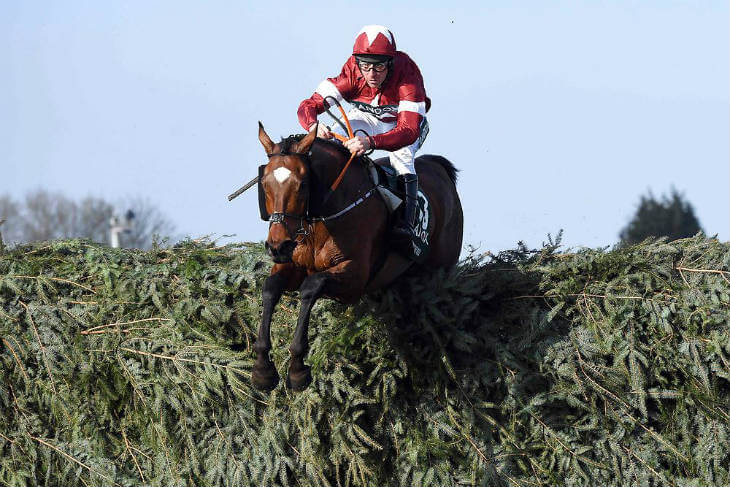Aintree – Getting to know the Grand National fences

Jockey Davy Russell jumps the last fence on Tiger Roll on his way to winning the Grand National horse race on the final day of the Grand National Festival at Aintree Racecourse in Liverpool, northern England on April 14, 2018. / AFP PHOTO / PAUL ELLIS @SCANPIX
There are no more famous fences in racing than those at Aintree over the Grand National course.
The much-talked-about set of obstacles in a lot of cases have their own names and they are enshrined in the folklore of The People’s Race at the Liverpool venue.
Of course, the modern era has seen many changes and alterations to the Aintree fences but they remain a key part of the Grand National story.
History
Dating back to 1829, racing over fences at Aintree Racecourse has evolved over the years, proving to be one of the most challenging tests, over distance, for runners and riders.
In total there are 16 fences on the Grand National course, 14 of which are jumped twice along the four mile-two-and-half-furlong distance.
They are currently created from Sitka or Norway spruce, which is brought down from the Lake District, and it is weaved into plastic birch structure which provides flexibility should a runner make a mistake at the jump.
It takes the Aintree ground staff team three weeks to build the fences from 16 lorry-loads of spruce prior to the Grand National Festival in April.
There are many well-known fences at Aintree including Becher’s Brook, the Canal Turn and Valentine’s, all of which provide different tests for the runners and riders. Perhaps the most storied of them all is Foinavon, which takes its name from the 1967 National winner – who benefitted from a melee that took many of his rivals out of the race at the fence that now bears his name.
Each fence varies in height, with the lowest measuring at 4ft 6in and the highest, The Chair, at 5ft 2in, which also has a 5ft wide ditch on the take-off side.
Aintree’s most famous fences
Here is some more info on some of the best-known of the Aintree obstacles.
Becher’s Brook
Jumped as: 6 & 22 – 4ft 10in high, 7ft 6in wide
The most famous fence in the Grand National race is named after Captain Martin Becher who landed in the ditch after being unseated by Conrad in the first official Grand National race in 1839.
This fence has been remodelled several times, with the drop on the landing side levelled in the 1990s and again after the 2011 Grand National race.
Foinavon
Jumped as: 7 & 23 – 4ft 6in high, 3ft wide
This otherwise ordinary fence became extraordinary in 1967, when Foinavon was the only horse to successfully jump the fence after multiple horses shied and caused chaos on the course, going from last place to win the race.
The Canal Turn
Jumped as: 8 & 24 – 5ft high, 7ft wide
This fence gets its name from the nearby Leeds-Liverpool canal and is noted for the sharp, 90-degree, left-hand turn that the runners have to take as soon as they have jumped the fence.
Valentine’s Brook
Jumped as: 9 & 25 – 5ft high, 7ft wide
With a 5ft 6in brook on the landing side, this fence was originally known as Second Brook, but was renamed after a horse called Valentine was said to have jumped it hind legs first in 1840.
The Chair
Jumped as: 15 – 5ft 2in
The highest fence in the race at 5ft 2in, The Chair has a 5ft ditch before the fence and a raised landing side. Jumped only on the first circuit, it is named after the chair the distance judge used to sit in to gauge the official distance between the winner and the runners behind.




